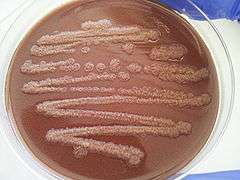Pseudomonas stutzeri
Pseudomonas stutzeri is a Gram-negative, rod-shaped, motile, single polar-flagellated, soil bacterium first isolated from human spinal fluid.[1][2] It is a denitrifying bacterium,[3] and strain KC of P. stutzeri may be used for bioremediation as it is able to degrade carbon tetrachloride.[4] It is also an opportunistic pathogen in clinical settings, although infections are rare.[5] Based on 16S rRNA analysis, P. stutzeri has been placed in the P. stutzeri group, to which it lends its name.[6]
| Pseudomonas stutzeri | |
|---|---|
 | |
| Scientific classification | |
| Kingdom: | Bacteria |
| Phylum: | |
| Class: | |
| Order: | |
| Family: | |
| Genus: | |
| Species: | P. stutzeri |
| Binomial name | |
| Pseudomonas stutzeri (Lehmann and Neumann 1896) Sijderius 1946 | |
| Type strain | |
| ATCC 17588 CCUG 11256 | |
| Synonyms | |
|
Bacillus denitrificans II Burri and Stutzer 1895 | |
Natural genetic transformation
Several different strains of P. stutzeri have been found to be competent for genetic transformation.[7] Natural genetic transformation is a sexual process involving DNA transfer from one bacterial cell to another through the intervening medium, and the integration of the donor sequence into the recipient genome by homologous recombination. Transformation can occur with high frequency between individuals of the same P. stutzeri strain, but is greatly reduced between individuals of different strains, or between P. stutzeri and individuals of other pseudomonas species.[7]
The complete genome sequence of the highly transformable P. stuzeri strain 28a24 has been determined.[8]
The P. stutzeri group
P. stutzeri lends its name to a subgroup within the genus Pseudomonas. The other members of the P. stutzeri subgroup are P. balearica and P. luteola.[6]
References
- Lehmann, KB, and Neumann, R. Atlas und Grundriss der Bakteriologie und Lehrbuch der speziellen bakteriologischen Diagnostik, 1st ed. J.F. Lehmann, München, 1896.
- Sijderius, R. "Heterotrophe bacterien, die thiosulfaat oxydeeren." Thesis, University Amsterdam, 1946, pp. 1–146.
- Lalucat; Bennasar, A; Bosch, R; García-Valdés, E; Palleroni, NJ; et al. (2006). "Biology of Pseudomonas stutzeri". Microbiol Mol Biol Rev. 70 (2): 510–47. doi:10.1128/MMBR.00047-05. PMC 1489536. PMID 16760312.
- Sepulveda-Torres; Rajendran, N; Dybas, MJ; Criddle, CS; et al. (1999). "Generation and initial characterization of Pseudomonas stutzeri KC mutants with impaired ability to degrade carbon tetrachloride". Arch Microbiol. 171 (6): 424–9. doi:10.1007/s002030050729. PMID 10369898.
- Noble RC, Overman SB (1994) Pseudomonas stutzeri Infection: A Review of Hospital Isolates and a Review of the Literature. Diagn Microbiol Infect Dis 19:51–56
- Anzai; Kim, H; Park, JY; Wakabayashi, H; Oyaizu, H; et al. (Jul 2000). "Phylogenetic affiliation of the pseudomonads based on 16S rRNA sequence". Int J Syst Evol Microbiol. 50 (4): 1563–89. doi:10.1099/00207713-50-4-1563. PMID 10939664.
- Lorenz MG, Sikorski J (2000). "The potential for intraspecific horizontal gene exchange by natural genetic transformation: sexual isolation among genomovars of Pseudomonas stutzeri". Microbiology. 146 Pt 12 (12): 3081–90. doi:10.1099/00221287-146-12-3081. PMID 11101666.
- Smith BA, Dougherty KM, Baltrus DA (2014). "Complete Genome Sequence of the Highly Transformable Pseudomonas stutzeri Strain 28a24". Genome Announc. 2 (3). doi:10.1128/genomeA.00543-14. PMC 4047452. PMID 24903873.
External links
- Migula's Systematic Bacteriology (in German)
- Type strain of Pseudomonas stutzeri at BacDive – the Bacterial Diversity Metadatabase